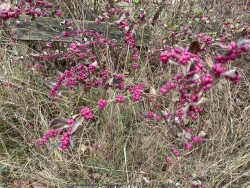
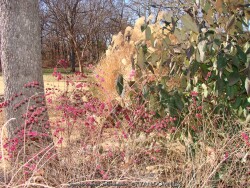
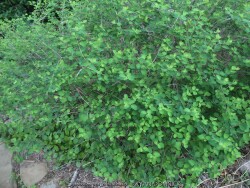
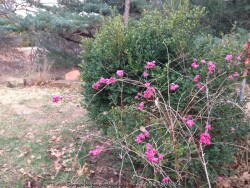

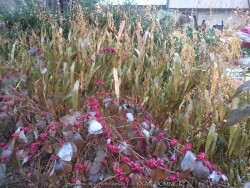
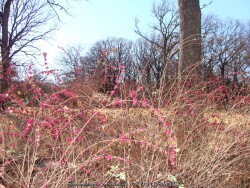
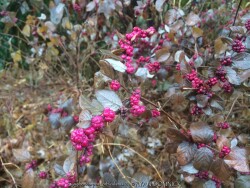
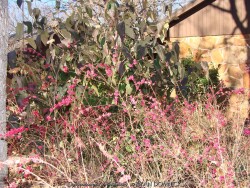
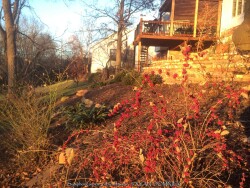

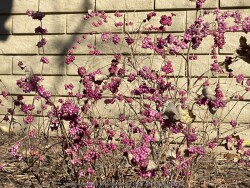
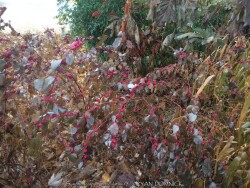



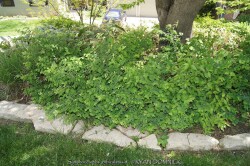
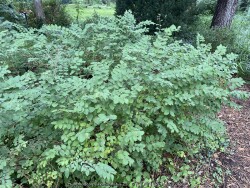
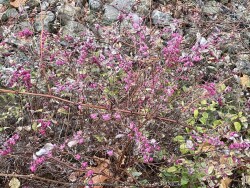
Plant Min Zone: 2b
Plant Max Zone: 8b
Sunlight: Part Sun, Shade
Water / Rainfall: Very Low, Low, Average
Soil Quality: Poor, Average, Rich
Bloom Season: Early Summer
Flower Color: White, Light Pink
Berry / Fruit Color: Magenta
Spring Foliage Color: Mint Green
Summer Foliage Color: Mint Green
Fall Foliage Color: Mint Green, Yellow
Evergreen Foliage: No
Winter Interest: Yes
Scented Flowers: No
Drought Tolerance: High
Wet-Feet Tolerance: Medium
Humidity Tolerance: Medium, High
Wind Tolerance: Medium, High
Poor Soil Tolerance: Clay Soils, Rocky Soils, Sandy Soils, Shallow Soils, Alkaline Soils (high PH), Acidic Soil (low PH)
Height: 2' - 3'
Width: 3' - 5'
Growth Rate: Medium
Service Life: Very Long: 10-20 years
Maintenance Need: Low
Spreading Potential: Medium
Yearly Trimming Tips: Trim Shrub to Desired Size in Late Winter or Early Spring Before New Growth: Blooms on New Wood.
Plant Grouping Size: Medium Grouping of 5-10, Mass Planting of 10 or more
Best Side of House: East Exposure, North Exposure
Extreme Planting Locations: Survives Under Roof Overhang, Root-Bound Soils Under Tree, Survives Severe Drought, Resistant to Rabbits
Ornamental Features: Long Lasting Fall Color, Bright Winter Color, Multiple Seasons of Interest
Special Landscape Uses: Naturalizing, Hedge Row
Possible Pest Problems: Weed Competition
Plant Limitations: Aggressive Rhizomes / Runners, Sometimes Mistaken as Weed
Shippable in 2026: YES
Coralberry (Symphoricarpos orbiculatus) is a spreading dwarf shrub native to much of the central and eastern United States including Kansas. It features mint green leaves that remain attractive all summer. Light pink flowers are barely noticeable but attractive upon close inspection. Ornamental clusters of magenta berries in the fall are the main attraction! The berries are very freeze-hardy clinging onto the leafless stems throughout most of the winter regardless of the minimum temperatures. This creates quite a show providing excellent color and interest to the winter landscape. While edible for some birds including robins, they seem to avoid the fruits unless it's a last resort. Coralberry is commonly grown as a spreading groundcover shrub for difficult areas. It will grow in full sun or full shade in medium to dry soils including dry-shade. It tolerates moist soil and floods for short periods of time. Fall leaf color is non-existent but ok because of the berry display. A brief window of time exists in the fall where the plant has beautiful green foliage and contrasting magenta berries at the same time. In the landscape, it is commonly used as large mass planting on hills. Because of its tolerance for adverse conditions including poor soil and rock, it is often one of the last resort plants that will survive in certain areas. It competes well under large shade trees and helps absorb leaf litter allowing it to break down and add nutrients back to the soil. This plant also does well in full sun; berry density is much greater in full sun. Plants can also be planted on the north side of a house, being extremely cold hardy with no winterkill. Another great spot is planting on top of a retaining wall allowing it to cascade down. We do not recommend planting in small areas or in spaces that it will overrun neighboring plants. It only spreads above ground as horizontally growing stems touch the ground and root. This does make maintenance easier to control the spread of the plant versus digging out rhizomes. Considered one of the best plants for solving your most difficult dry-shade landscape challenges.